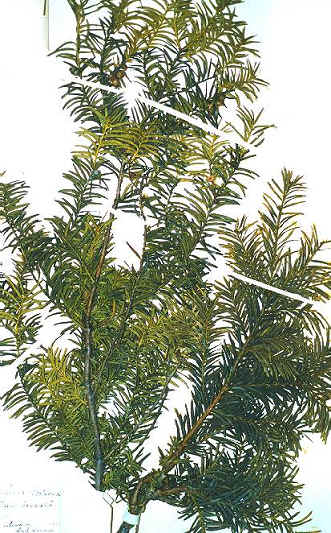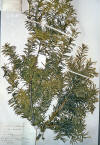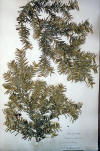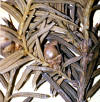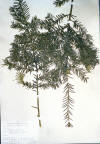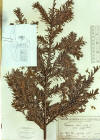|
Taxus baccata (var.) monstruosa Carrière, Traité gén. conif. 519. 1855. Taxus baccata (f.) monstruosa Beissner, Handb. Nandelholzk. 175. 1891. Original material unknown. Neotype proposed: England: Surrey, Box Hill, 2 Sep. 1899, Fraser (K with seed!). Lock Lomond Yew (Loudon 1844) or Scottish yew. Distribution: Scotland, England. Erect shrubs or trees with wide ascending branches and branchlets; leaves radial, not closely overlapping as in var. fastigiata, recurved; the abaxial epidermal cells narrow fusiform, strongly papillose, or irregularly rectangular and partly smooth on midrib, lacking papillae on 4–7 rows of cells from margins. This variety is distinguished from the typical variety by its narrower, more densely papillose leaves that are less crowded on branchlets, which have a yellowish tint on young growth. The two specimens studied from England and Scotland are remarkably similar, although probably of hybrid origin with T. recurvata as a parental type. Loudon (1844) reported that more than 300 trees of this yew had occurred on “Inch Lomond Island,” commonly known as “Yew Tree Island.” Plants reportedly attained a height of “40 ft” and “13 ft. in girt.” A historical review by Mitchell (1974) indicated that yew could have been introduced to “Inchlonaig” by “King Robert the Bruce” during the 14th century in order to maintain a source of wood for long bows used by “the men on Lennox, a former province combining south-west Stirlingshire with Dunbartonshire.” Mitchell (1974) further questioned the natural existence of yew in Scotland based on the lack of paleotological evidence (see also Godwin 1975). In any case, Scottish yew also suffered further losses from browsing by goats introduced to the island in 1794, and from cutting of trees between 1814 and 1819 for bows (Mitchell 1974). Yew was replanted on the island in 1836 but again was diminished by goats until goats were extirpated from the island (Mitchell 1974). In 1972, Mitchell (1974) counted “800 mature trees” on the island, occurring “in clumps and scattered individuals.”Additional Specimen—England: Kent, Shorehand, Jarrell (K). Cultivated: Australia—New South Wales: Botanical Gardens, Sydney, 8 Dec 1908, T. baccata var. argentea,
|
